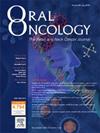Outcomes following IMRT alone in head and neck squamous cell carcinoma ordinarily managed with concurrent chemo-radiotherapy
IF 4
2区 医学
Q1 DENTISTRY, ORAL SURGERY & MEDICINE
引用次数: 0
Abstract
Purpose/Objective(S)
We report outcomes following IMRT-alone in patients with head-and-neck squamous cell carcinoma (HNSCC) ordinarily managed with concurrent chemo-radiotherapy.
Materials/Methods
HNSCC (excluding T1-2 N0) patients treated with IMRT-alone from 2005 to 2019 were included and restaged according to TNM-8. Overall survival (OS) was stratified by TNM-8 stage subgroups within HPV-positive (HPV + ) and separately within HPV-negative (HPV–) HNSCC. Multivariable analysis (MVA) identified prognostic factors for OS.
Results
A total of 460 patients with HPV + and 623 HPV– HNSCC were identified. Reasons for chemotherapy omission were: age > 70 years and/or frailty (n = 551, 51 %), cisplatin contraindication (n = 241, 22 %), patient’ preference (n = 106, 10 %), and clinician’s decision (n = 185, 17 %). IMRT was delivered mostly using altered-fractionation: moderately-accelerated (70 Gy/35 fractions [f]/6 weeks [w], 55 %), hypofractionated (60 Gy/25f/5w, 14 %), and hyperfractionated-accelerated (64 Gy/40f/4w, 25 %). Median follow-up was 5.0 years. Five-year OS for HPV + stage-I-single node, stage-I-multiple nodes, stage-II-T1-2 N2, stage-II-T3 N0-N2, and stage-III were 90 %, 79 %%, 80 %, 64 %, and 33 %, and for HPV– stage III, IVA, and IVB were 47 %, 27 %, and 13 %, respectively. MVA confirmed lower OS in HPV + stage-I-multiple nodes (p = 0.03), II-T3 N0-N2 and III (vs stage-I-single node) and HPV– stage IVA/IVB (vs III) (p < 0.01), and marginally lower OS in HPV + stage-II-T3 N0-2 (vs I-single node) (p = 0.07).
Conclusion
Altered fractionated IMRT-alone is a valid option for patients with HPV + stage I-single node HNSCC, and an acceptable alternative for elderly/frail or cisplatin ineligible patients with HPV + stage I-multiple nodes and T1-2 N2 HNSCC. Patients with HPV + T3-T4 or N3 and HPV– stage III/IV HNSCC had unsatisfactory OS, requiring further research into alternative options.
单用IMRT治疗头颈部鳞状细胞癌的结果,通常采用同步放化疗
目的/目的(S):我们报道了头颈部鳞状细胞癌(HNSCC)患者单独imrt治疗后的结果,这些患者通常采用同步放化疗治疗。材料/方法纳入2005年至2019年单独接受imrt治疗的shnscc(不包括T1-2 N0)患者,并根据TNM-8进行再分期。总生存期(OS)在HPV阳性(HPV +)和HPV阴性(HPV -) HNSCC中按TNM-8期亚组分层。多变量分析(MVA)确定了OS的预后因素。结果共检出460例HPV +和623例HPV - HNSCC。遗漏化疗的原因有:年龄;70岁和/或虚弱(n = 551,51 %),顺铂禁忌症(n = 241,22 %),患者偏好(n = 106,10 %)和临床医生决定(n = 185,17 %)。IMRT主要采用改变分级方式:中度加速(70 Gy/35次[f]/6周[w], 55%)、低分级(60 Gy/25f/5w, 14%)和高分级加速(64 Gy/40f/4w, 25%)。中位随访时间为5.0年。HPV + i期单淋巴结、i期多淋巴结、ii期t1 -2 N2、ii期t3 N0-N2和III期的5年OS分别为90%、79%、80%、64%和33%,HPV -III期、IVA和IVB的5年OS分别为47%、27%和13%。MVA证实HPV + i期多淋巴结(p = 0.03)、ii期t3 N0-N2和III期(与i期单淋巴结相比)和HPV - IVA/IVB期(与III期相比)的OS较低(p <;0.01), HPV +分期- ii - t3 N0-2的OS略低(与i -单节点相比)(p = 0.07)。结论单独改变分级imrt治疗HPV + i期单淋巴结HNSCC是一种有效的选择,对于老年人/体弱或顺铂不适合的HPV + i期多淋巴结和T1-2 N2 HNSCC患者也是一种可接受的选择。HPV + T3-T4或N3和HPV - III/IV期HNSCC患者的OS不满意,需要进一步研究替代方案。
本文章由计算机程序翻译,如有差异,请以英文原文为准。
求助全文
约1分钟内获得全文
求助全文
来源期刊

Oral oncology
医学-牙科与口腔外科
CiteScore
8.70
自引率
10.40%
发文量
505
审稿时长
20 days
期刊介绍:
Oral Oncology is an international interdisciplinary journal which publishes high quality original research, clinical trials and review articles, editorials, and commentaries relating to the etiopathogenesis, epidemiology, prevention, clinical features, diagnosis, treatment and management of patients with neoplasms in the head and neck.
Oral Oncology is of interest to head and neck surgeons, radiation and medical oncologists, maxillo-facial surgeons, oto-rhino-laryngologists, plastic surgeons, pathologists, scientists, oral medical specialists, special care dentists, dental care professionals, general dental practitioners, public health physicians, palliative care physicians, nurses, radiologists, radiographers, dieticians, occupational therapists, speech and language therapists, nutritionists, clinical and health psychologists and counselors, professionals in end of life care, as well as others interested in these fields.
 求助内容:
求助内容: 应助结果提醒方式:
应助结果提醒方式:


